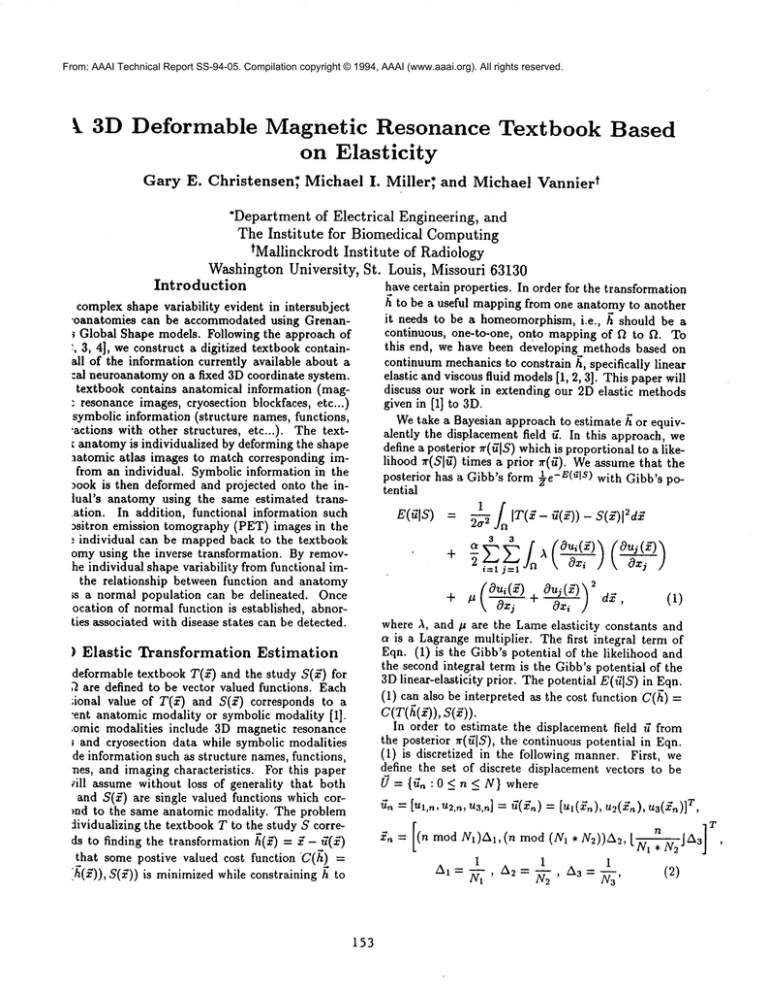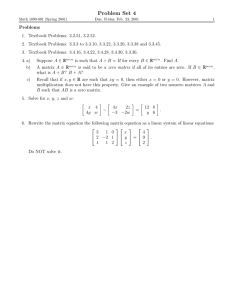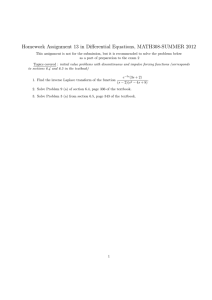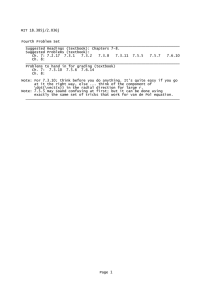
From: AAAI Technical Report SS-94-05. Compilation copyright © 1994, AAAI (www.aaai.org). All rights reserved.
k 3D Deformable
Magnetic Resonance
on Elasticity
tGary E. Christensen,
Michael
I.
Miller;
Textbook
and Michael
Based
Vannler
*Department of Electrical
Engineering,
and
The Institute
for Biomedical Computing
tMallinckrodt
Institute
of Radiology
Washington University,
St. Louis, Missouri 63130
Introduction
have certain properties. In order for the transformation
f~ to be a useful mapping from one anatomy to another
complex shape variability evident in intersubject
it
needs to be a homeomorphism, i.e., h should be a
¯ oanatomies can be accommodated using Grenancontinuous, one-to-one, onto mapping of f~ to fL To
Global Shape models. Following the approach of
this end, we have been developing methods based on
:, 3, 4], we construct a digitized textbook containall of the information currently available about a
continuum mechanics to constrain h, specifically linear
:al neuroanatomy on a fixed 3D coordinate system.
elastic and viscous fluid models[1, 2, 3]. This paper will
textbook contains anatomical information (magdiscuss our work in extending our 2D elastic methods
: resonance images, cryosection blockfaces, etc...)
given in [1] to 3D.
symbolic information (structure names, functions,
Wetake a Bayesian approach to estimate h or equiv¯ actions with other structures, etc...). The textalently the displacement field 3. In this approach, we
anatomy is individualized by deforming the shape
define a posterior ~’(g[S) whichis proportional to a like.1atomic atlas images to match corresponding iralihood a’(S[~) times a prior ~r(g). Weassume that
from an individual. Symbolic information in the
posterior has a Gibb’s form ½e-E(~ls) with Gibb’s po~ook is then deformed and projected onto the intential
lual’s anatomy using the same estimated trans.ation. In addition, functional information such
E(~IS ) - 1
2~," IT(J- Z(~)) - S’(aT)[~da~
~sitron emission tomography (PET) images in the
.~ individual can be mapped back to the textbook
omyusing the inverse transformation. By removhe individual shape variability from functional imthe relationship between function and anatomy
~s a normal population can be delineated. Once
ocation of normal function is established, abhorties associated with disease states can be detected.
where A, and p are the Lameelasticity constants and
a is a Lagrange multiplier. The first integral term of
Eqn. (1) is the Gibb’s potential of the likelihood and
} Elastic
Transformation
Estimation
the second integral term is the Gibb’s potential of the
deformable textbook T(g) and the study S(~)
3Dlinear-elasticity prior. The potential E(glS) in Eqn.
,2 are defined to be vector valued functions. Each
(1) can also be interpreted as the cost function C(h)
;ional value of T(£) and S(g) corresponds
C(T(f~( ~)S(~)
¯ ent anatomic modality or symbolic modality [1].
In order to estimate the displacement field ff from
~omic modalities include 3D magnetic resonance
the posterior ~(glS), the continuous potential in Eqn.
and cryosection data while symbolic modalities
(1) is discretized in the following manner. First,
de information such as structure names, functions,
define the set of discrete displacement vectors to be
nes, and imaging characteristics.
For this paper
:ill assume without loss of generality that both
={g, :0<n<N} where
and S(~) are single valued functions which corT,
l~n "- ["l,n,
U2,n, ~3,n] = U(;~n) = [t~l(Zn),
U2(~n), ".3(X.)]
,nd to the same anatomic modality. The problem
~lividualizing the textbook T to the study S corre~’. = ( n rood N1)A1, (n mod (N1 * N2))A2, [~JA3
ds to finding the transformation h(~) = ~- if(aT)
that some postive valued cost function ’C(h)
1
1
1
f~(~’)), S(~)) is minimizedwhile constraining
[
153
. IT
It has been shown that under the proper conditions
that the empirical average of the samples from the SDE
converge to the conditional meanof the posterior [4, 5],
where 0 < n < NI*N2*N3 = N, N is the total number
of voxels in the study S(£), and Ai, i = 1, 2, 3 are the
y, and z separation distances between displacement field
samples. If we set a = 2, A = 1, and p = 1 to simplify
the notation, Eqn. (1) has the discretized form
i.e.,
M
lim 1
M-.oo
N
a=O
(3)
where pj(ui,,) ui (~n + Ajgj) is the plus shift operator, rnj(ui,n) ui (~n - Ajgj) is the minus shift
operator, and g/ is the jth unit vector. The evaluation
of T(gn -fin) is performed using trilinear interpolation
because both the template T and the study S are stored
digitally on the computer by the samples Tn = T(~,)
and Sn = S(gn). With this discretized representation
of if, the numberof parameters required to estimate the
transformation of the textbook anatomy to the individual anatomy is three times the number of voxels.
The vector of displacement vectors [7 are estimated
by drawing samples from the posterior distribution
7r(UIS ) c¢ ½e-s(OIs) where E(~IS) is given in Eqn.
(3) using the Stochastic Differential Equation (SDE)
d~t = -~OoE(EIS)dt
W(t)]
where
[ffr(t+6)- ffz(t)],,, N(0,
3
j=l
hi,.= [S(~.)- T(£.- if.)]~ z.-a.
and for i # j, gi,j(Uk,n) (Irk,n))
-- rrti(Pj
A~Aj
(Bk,n) --
Implementation
The solution
of Eqn(5) was implemented using
64 x 64 DECmpp12000Sx/Model 200 (MasPar) singleinstruction-multiple-data
(SIMD), massively-parallel
computer. The mesh-connected nature of the processor elements is well suited to computing Eqn. (5)
parallel because Eqn. (5) has only local and nearest
neighbor data dependency. The DECmppis well suited
for calculating the 3D transformation of the textbook
T(~n - ~,) required at each iteration because of its
global router and ability to perform parallel indirect
~ was
memory addressing.
In addition,
the DECmpp
able to solve this computationally intense algorithm in
reasonable time frames.
Results
(4)
+ dI4,’t,
U(t+6) = 0(0- ~ VO E(U, IS)~+[W(t+6)-
(Uk,n) -- rrtj
(7)
In this section we will describe the performance of
the 3D elastic transformation procedure as it was used
to deform an MPRAGE
magnetic resonance textbook
volume into the shape of a study volume. Figure 1
shows the 128 x 128 x 148 MPRAGEvolume used in
this experiment for the textbook (top) and the study
(bottom-left).
The original data was down sampled
from 256 x 256 x 128 using trilinear interpolation and
was padded by 10 planes of zero intensity background
on top and bottom of the volume in the z-direction.
The volumes displayed in this figure were generated by
surface rendering the fatty tissue of the head and replacing the top surface of the head with the proper axial MPRAGE
data slice. Notice that even though the
two MPRAGE
volumes were cut at the same data slice,
that the anatomy differs greatly from the textbook and
the study. Also notice how different the faces of the
textbook and the study are.
The transformation of the textbook into the study
was estimated in the following manner. In a preprocessing step, the gray scale histograms of the study and
the textbook were matched. This step was performed
to ensure that commonstructures in the textbook and
the study had relatively the same average grey-level values. The estimation of the elastic transformation was
estimated using a two step approach based on the idea
of multi-resolution. In the first step, the global shape
differences between the textbook and the study were
accommodated using the Karhunen-Loeve elastic basis
where V0 is the gradient with respect to the elements
of 0 and Wt is a standard vector-valued Wiener process
with independent components. Eqn. (4) is realized
the computer by its discretized version
Pi(Pj
(glS) dg
i=1
where/4 is the set of all possible displacement fields in
the
). support of 7r(~71S
n=0
i,j=l
g’’ =fu g
mj (uk,.))
(6)
154
~The 64 x 64 DECmpp12000Sx/Model 200 (MasPar)
rated at 1.6 MFLOPs
for 32-bit operands.
~sentation
thatis described
in [3].Thisis a 3D
rigidelastic
deformation
of thetextbook
intothe
y. Theglobal
transformation
estimated
in thefirst
wasthenusedas theinitial
transformation
forthe
ic procedure
described
in thispaperto accommolocalshapevariability.
Forthisexample,
we as~d thatthedisplacement
fieldat theboundary
of
lomainof thetextbook
waszero.Theresulting
3D
ic deformation
of the MPRAGEtextbook
intothe
y is shownin thebottom-right
panelof Figure1,
ce howsimilarthe anatomyof the deformed
(inlualized)
textbook
is to thatof thestudyvolume,
howsimilar
thesurfaceof thedeformed
textbook
istothestudyface.
Table 1: 3D Elastic Deformation Times
IExp. I DataSize] N°’°fIN°’°flParam.IIter. I Time
I
"basis
I 64x64x74 I 192
100 I llmin
spatiall128
x 128 x 14817.3 x 106 500 19.5 hours
I
tal MPRAGE
slices 74 and 62 from the textbook (top),
study (middle), and elastically deformed textbook (bottom), respectively. Once again comparing the textbook
images to the study images, we see that there is anatomical shape differences in all three coordinate directions.
Notice how different the shape of the corpus callosum
of the study (middle-left) is to the textbook (top-left)
and how similar it is to the deformed textbook (bottomleft). Looking at the right column of Figure 2, notice
how similar the shape of the eye sockets, nasal cavity, ventricles, cortical folds, and cerebellum are in the
study and deformed textbook.
:e 1: The result of elastically deforming the textMPRAGE
volume (top) into the shape of the
’ MPRAGE
volume (bottom-left)
is shown in the
,m-right panel. Notice the similarity between the
surface and the internal anatomical structures of
ottom two panels¯
e execution time for the 3D elastic deformation
MPRAGE
textbook into the study for both the
.l and local procedures on the DECmppis tabuin Table 1. The DECmppimplementation ex~d the parallel architecture so that half of the ex)n time was communication and half computation
ng -~ 0.8 GFLOPperformance. The 9.5 hours red for the local deformation is dependent on the
step-size 6 and on the number of iterations used.
er the step-size or the number of iterations were
fized for speed in this result.
e left and right columns of Figure 2 shows sagit-
Figure 2: The left and right columns show sagittal
MPRAGEslices 74 and 62 from the MPRAGEtextbook (top), study (middle), and elastically deformed
textbook (bottom), respectively¯
The parameterization of the displacement field estimated in the elastic basis transformation is low dimensional because only 192 parameters or basis coef-
155
flcients were estimated. On the other hand, the parameterization of the displacement field in Eqn. (2)
is a high dimensional transformation because it has
3 x 128 x 128 x 148 = 7.3 x l0 s parameters for this
MPRAGE
data set. The left column of Figure 3 shows
the x-, y-, and z-components of displacement field J(~)
from top to bottom used to generate sagittal slice 74 of
the elastically deformed textbook. Likewise, the right
column of Figure 3 shows the x-, y-, and z-components
of U(~) for sagittal slice 62 of the deformed textbook.
The bright regions in these images correspond to positive displacements and dark regions correspond to negative displacements. The low frequency components of
these images correspond to global deformations of the
textbook while the high frequency components correspond to local deformations of the textbook.
GFLOPcomputational performance. Algorithm performance was assessed subjectively by comparing the
facial soft tissue surface and anatomical structure for
an individual study with the deformed textbook, noting their high degree of similarity.
Acknowledgements
Wewould like to thank Jing Wangand Sarang Joshi for
their help in the 3D visualization of the MPRAGE
data.
This work was supported by the NIH-NCRR-RR01380,
ONRN00014-92-J-1418, AROP-29349-MA-SDI, and a
grant from the Digital Equipment Corporation.
References
[1] M.I. Miller, G.E. Christensen,
Y. Amit, and
U. Grenander. Mathematical
textbook of deformable neuroanatomies. Proceedings of the National Academy of Science, 90(24), December 1993.
[2] G. E. Christensen, R. D. Rabbitt, and M.I. Miller.
A deformable neuroanatomy textbook based on
viscous fluid mechanics. In Jerry Prince and
Thordur Runolfsson, editors, Proceedings of the
Twenty-Seventh Annual Conference on Information
Sciences and Systems, pages 211-9.16, Baltimore,
Maryland, March 24-26 1993. Department of Electrical Engineering, The Johns Hopkins University.
[3] G. E. Christensen,
R. D. Rabbitt,
and M.I.
Miller. 3D brain mapping using a deformable neuroanatomy. Physics in Medicine and Biology, (accepted Oct 1993).
[4] U. Grenander and M. I. Miller. Representations of
knowledge in complex systems. Journal of the Royal
Statistical Society B, 56(3), 1994.
[5] Y. Amit, U. Grenander, and M. Piccioni. Structural
image restoration through deformable templates. J.
American Statistical Association, 86(414):376-387,
June 1991.
Figure 3: The left and right columns show the x- (top),
y- (middle), and z-components (bottom) of the
placement field U(~) used to generate slices 74 and
of the elastically deformedtextbook, respectively.
¯
Summary
and Conclusions
A high-dimensional 3D elastic deformation procedure
for accommodating local shape differences between a
deformable textbook and a study was developed. This
algorithm was implemented using the massively-parallel
DECmpp12000Sx/Model 200 (MasPar) yielding -.~ 0.8
156



